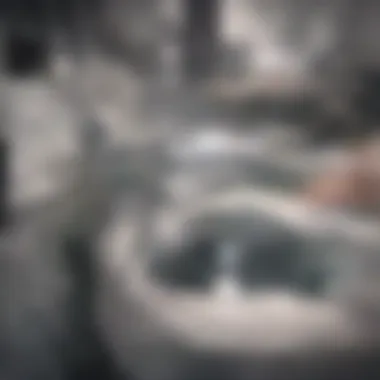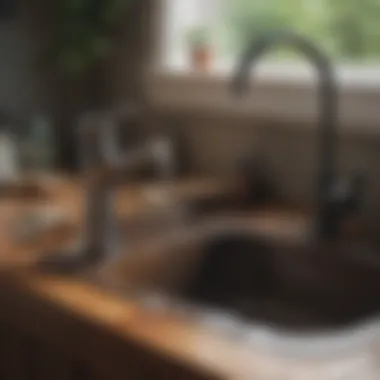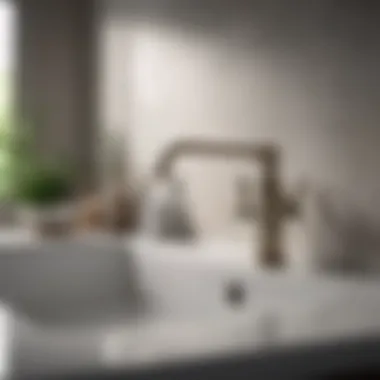Effective Solutions for Clogged Sinks: Your Complete Guide


Intro
Clogged sinks are a universal inconvenience. The frustration of water unable to drain can disrupt daily routines and diminish the comfort of any space. Understanding the root causes of these clogs provides insight into effective remedies. Not only is it important to solve the immediate issue, but also to address and prevent future occurrences.
In this guide, we will cover various methods to clear a clogged sink. This includes household remedies, commercial products, and professional services for serious blockages. We will delve into how clogs develop, and emphasize the importance of regular maintenance and preventive measures for a well-functioning plumbing system.
Both homeowners and renters alike should find value in this extensive exploration of sink care. Furthermore, real estate professionals can also benefit from knowledge about maintaining plumbing, enhancing property value and livability.
"Effective routine maintenance will save time and future expenses regarding clogged sinks."
By the end of this article, you will have a toolkit of strategies to manage any clog situation effectively.
Preface to Clogged Sinks
Clogged sinks are a prevalent issue that many individuals encounter in their daily lives. Understanding the dynamics of clogged sinks is essential for homeowners and renters alike. The frustration of dealing with a slow or blocked sink can disrupt daily routines and lead to further plumbing issues if not addressed promptly.
This section aims to highlight the significance of recognizing the signs of clogged sinks and understanding their underlying causes. With an insightful comprehension of this issue, individuals can take proactive measures. Furthermore, knowing how to assess the severity of a clog aids in determining whether a DIY solution or professional help is needed. With this knowledge, anyone can approach plumbing problems with confidence.
Understanding the Problem
Clogs can develop for various reasons and often go unnoticed until they become severe. They typically stem from a combination of the materials entering the drainage system and the design of the plumbing itself. It is important to grasp how clogs form to approach their resolution more effectively. By being aware of the common indicators of a clogged sink, owners can mitigate potential damage and costly repairs.
Common Causes of Clogs
Food Residue
Food residue is a leading cause of clogged sinks, occurring mainly in kitchen sinks. When food scraps go down the drain, they can accumulate over time, forming solid barriers that impede water flow.
The sticky nature of some food particles makes them particularly problematic. Material like rice, pasta, and greasy sauces can bond together, creating a near-impenetrable mass. Recognizing the importance of managing food waste properly can significantly reduce the likelihood of clogs.
Hair Buildup
Hair buildup is another common culprit, especially in bathroom sinks and showers. Hair can easily collect around drain openings and combine with soap scum and other debris. This combination can lead to a substantial blockage, disrupting drainage.
Unlike other causes, hair has a strong tendency to tangle and create clogs that can be difficult to remove. This illustrates the necessity of taking preventive measures when managing hair and other products to avoid future plumbing challenges.
Grease and Oil
Grease and oil represent a significant threat to sink drainage systems. When they are poured down the drain, they may initially flow smoothly. However, as they cool, they solidify and combine with other substances, leading to blockages.
The incorrect disposal of cooking oils poses a considerable risk to long-term plumbing efficiency. Understanding how these substances interact with drainage systems allows homeowners to identify more effective disposal alternatives, ultimately securing their plumbing systems.
Initial Assessment
Conducting an initial assessment of a clogged sink is crucial for effective problem-solving. Before adopting any solutions, understanding the nature and symptoms of the clog can lead to better outcomes. By identifying key indicators of a clog, one can efficiently decide on the next steps to unclog the sink. This process not only helps in addressing the immediate issue of drainage but also promotes ongoing maintenance habits.
Signs of a Clogged Sink
Several signs can indicate that a sink is clogged. Recognizing these signs early is vital for preventing further damage or severe plumbing issues. Common indicators include:
- Water pooling in the sink: This is often the first sign that informs you of an obstruction in the drainage system.
- Unpleasant odors: Bacteria can grow in stagnant water, resulting in foul smells.
- Gurgling sounds: Air escaping through the blockage can create unusual noises when water flows through the pipes.
- Slow drainage: Water takes longer than usual to go down the drain.
Identifying these signs can prompt quick remedies, saving homeowners potential costs related to more extensive repairs.
Determining the Severity
Assessing the severity of the clog is an essential part of the initial evaluation. Two primary conditions indicate the extent of blockage: slow drainage and complete blockage.
Slow Drainage
Slow drainage is characterized by water that takes an extended time to disappear down the sink. This condition often suggests a partial obstruction. In terms of assessment, slow drainage can impact daily activities significantly. It's a common annoyance that hints at underlying problems. Ignoring slow drainage may lead to more severe issues down the line, making it a vital topic for discussion in this guide.
- Key Characteristic: The noticeable prolongation of water disappearance.
- Relevance: If addressed quickly, it can prevent future, more severe clogs.
- Advantages: Can often be resolved using simple DIY methods such as boiling water or using vinegar and baking soda.
- Disadvantages: If treated inadequately, it may worsen, leading to a complete blockage.
Complete Blockage


Complete blockage occurs when water is unable to flow down the drain at all. This is a critical situation that could indicate serious plumbing issues. Understanding this condition helps in prioritizing interventions. Homeowners often find complete blockage especially inconvenient, as it disables a sink's basic functionality.
- Key Characteristic: Water standing still in the sink, unable to drain.
- Relevance: Requires immediate attention and possibly professional intervention.
- Advantages: Recognizing it early can help in seeking timely resolution from professional services.
- Disadvantages: Can lead to plumbing damage if left unaddressed for too long.
Understanding the initial assessment steps is imperative. Neglecting these signs can lead to costly repairs.
DIY Solutions
The topic of DIY solutions for clogged sinks plays an essential role in this guide. Homeowners face the vexing issue of a clogged sink at some point. Tackling this problem without professional assistance can save time and money, making knowledge of effective DIY methods crucial. Many households have common items that can resolve minor clogs quickly. Knowing these methods not only empowers individuals to address their own plumbing problems but also fosters a sense of self-reliance. Understanding the benefits of these solutions encourages proactive maintenance, which is often overlooked.
Boiling Water Method
Using boiling water is one of the simplest DIY solutions for clearing a clogged sink. It can break down grease or soap residues that bind to the inner surfaces of pipes. Here's how to implement this method effectively:
- Boil water: Start by boiling a kettle of water.
- Pour in stages: Carefully pour the boiling water directly into the sink. It is wise to do this in two or three stages, allowing the water to sit for a few seconds each time.
- Wait: Give it a few minutes to work before checking if the clog has improved.
This method is particularly useful for kitchen sinks affected by grease. However, avoid this method for toilets and sinks made of plastic, as excessive heat can damage certain materials.
Vinegar and Baking Soda
Another effective solution is the use of vinegar and baking soda. This combination generates a foaming action that can help dislodge clogs. Here's how to use it:
- Measure and mix: Pour about a cup of baking soda down the drain, followed by a cup of vinegar.
- Cover: If possible, cover the drain with a cloth or stopper to keep the reaction contained.
- Wait: Let the mixture work for about 15 to 30 minutes.
- Flush: Finally, flush with warm water.
The reaction occurs as the baking soda and vinegar mix, effectively loosening clogs. This method is environmentally friendly and avoids harsh chemicals.
Using a Plunger
A plunger is a valuable tool and often essential for any DIY plumbing task. When using a plunger, follow these steps:
- Choose the right plunger: Use a cup plunger for sinks. Ensure it is in good condition.
- Seal and plunge: Place the plunger over the drain, ensuring it covers the hole completely. Create a seal and push down firmly, then pull up quickly to create suction.
- Repeat: Do this several times. If the water begins to drain, you are making progress.
This method may require persistence, but it is effective for many different types of clogs.
Wet/Dry Vacuum Approach
The wet/dry vacuum is often an underutilized tool for home plumbing problems. Here’s how to use it for clogged sinks:
- Set up the vacuum: Change it to liquid mode. Make sure it's clean and ready to go.
- Create a seal: If applicable, place the hose over the drain. Seal any gaps to maximize suction.
- Suck out the clog: Turn on the vacuum and let it operate. Monitor to see if any debris comes into the vacuum canister.
This method works well for stubborn clogs. It can be messy, so consider using towels around the area.
These DIY solutions provide a range of options for dealing with clogged sinks effectively. Each approach has its strengths and can be employed based on the nature of the blockage.
When to Call the Professionals
Clogged sinks can sometimes seem like a straightforward issue, but there are cases where home remedies fail to yield results. Knowing when to call in professional assistance becomes critical for maintaining the integrity of plumbing systems. This section addresses specific scenarios warranting expert input and illustrates the benefits associated with choosing professional services for persistent problems.
Identifying Advanced Problems
Persistent Clogs
Persistent clogs are an indicator that the blockage is more than just a minor inconvenience. Even after attempting various DIY methods, if the issue continues to reappear, it suggests deeper problems within the plumbing. These may include tree root intrusions, broken pipes, or extensive buildup of materials beyond what simple remedies can address.
The key characteristic of persistent clogs is their recurring nature. Homeowners may try to flush them out repeatedly, only to find that the situation does not improve. Such issues often require specialized tools and a trained eye to diagnose accurately. Attempting further DIY solutions risks causing more damage and potentially costs more. Thus, recognizing persistent clogs as a call for professional evaluation can prevent future complications and repair costs.
Multiple Fixtures Affected
When multiple fixtures simultaneously show signs of blockage, this situation signals systemic issues. For instance, if a kitchen sink, bathroom sink, and bathtub all drain slowly, the problem may lie in the main plumbing line rather than an isolated occurrence. Several key characteristics define situations like this. They are typically more complex and involve different sections of the plumbing system which interact with each other.
Noticing that multiple fixtures are affected serves as a critical sign that larger plumbing issues exist. This could involve shared drainage pathways or blockages in ventilation pipes. Engaging professionals in these cases becomes imperative. The unique feature of recognizing the correlation between various blockages lies in its potential to save time and money. If one waits too long, the issue could escalate to a full sewer backup, incurring greater costs and hassles.
Benefits of Professional Services
The decision to engage professionals can often result in lasting benefits. Certified plumbers bring experience and tools that empower them to tackle issues efficiently. They can swiftly diagnose underlying problems that an untrained eye may miss. Furthermore, professionals use environmentally safe methods to clear clogs, which might be safer for both the plumbing system and the environment.


Additionally, the guarantee of workmanship typically accompanies professional service. If after a repair the problem resurfaces, the same service can often address the concern again without extra charges. Not only does this provide peace of mind, but it also facilitates a satisfactory solution.
Preventive Measures
Preventive measures are essential to manage and avoid clogged sinks effectively. They not only save time and effort but also minimize costly repairs. By integrating routine practices into your daily habits, you can significantly reduce the likelihood of encountering severe clogs. Understanding prevention strategies empowers all homeowners and renters alike, ensuring the plumbing system remains efficient and reliable.
Regular Maintenance Practices
Routine Cleaning
Routine cleaning is a fundamental aspect of maintaining clear drainage in sinks. Regularly scheduled clean-ups help remove buildup before it becomes problematic. The key characteristic of routine cleaning is its simplicity and effectiveness in keeping drains clear. This practice can involve clearing out small debris from the sink or using a mild detergent to wash surfaces.
The unique feature of routine cleaning is that it can be done without specialized tools or expertise. Frequent attention to drains helps to obstruct any progressive buildup of materials that could lead to larger issues.
Advantages of routine cleaning include the reduction of unpleasant odors and visible debris. However, it requires discipline and consistency, as neglecting this practice might lead to bigger problems down the line.
Using Drain Strainers
Using drain strainers is another valuable preventive measure. These are devices designed to catch food particles, hair, and other debris before they enter the drainage system. The key characteristic of drain strainers is their ease of use and effectiveness in preventing clogs. They are simple screens placed over the drain, capturing potential blockages.
The unique feature of using drain strainers is their low cost and minimal maintenance requirements. They just need to be cleaned periodically, which is a minor task compared to dealing with a clog.
Advantages of drain strainers lie in their ability to prevent clogs effectively before they start. One drawback may be the need for occasional cleaning, but this task is generally manageable and does not require significant effort.
Mindful Disposal Habits
Managing Food Waste
Managing food waste is crucial for maintaining clear sinks. Proper disposal methods, such as using a waste disposal unit or composting, can prevent food residues from entering the pipes. The key characteristic of managing food waste is the awareness around what is disposed of in sinks versus trash.
The unique feature of managing food waste is the proactive approach to handling potential blockages. By scraping plates into the trash and washing dishes properly, individuals can significantly lower the chances of clogs.
Advantages of managing food waste effectively include enhanced drain health and less unpleasant smells. A disadvantage could arise if people don't adopt mindful habits, putting pressure on drainage systems.
Proper Use of Grease
Proper use of grease is essential in maintaining a healthy plumbing system. When cooking, it is common for grease to accumulate in sinks. The key characteristic here is the understanding that grease solidifies in pipes, leading to significant clogs.
The unique feature of proper grease use is that it encourages draining methods like pouring used grease into containers rather than down the sink. This approach helps prevent future plumbing issues and supports a cleaner environment.
Advantages include reduced maintenance needs and prolonged lifespan for plumbing systems. On the other hand, the inconvenience of disposing of grease separately might deter some individuals, but the long-term benefits greatly outweigh this minor drawback.
Proper disposal and regular maintenance can save significantly on repair costs and ensure efficient plumbing.
Understanding Plumbing Mechanics
Understanding the plumbing mechanics that underlie drainage systems is crucial for dealing with clogged sinks. This knowledge helps homeowners and renters alike to better grasp why clogs occur and how they can be effectively managed or prevented. Ultimately, a sound understanding of these mechanics can save both time and money.
How Drainage Systems Work
Drainage systems are designed to transport waste water away from sinks and other fixtures, ensuring that indoor plumbing remains functional. The primary components of a drainage system include pipes, fittings, and traps. Pipes channel wastewater away from the sink. Fittings connect different pipe sections, facilitating directional changes. Traps, typically U-shaped, hold a bit of water to prevent sewer gases from entering the home.
The angle at which pipes are installed is also very important. A slight downward slope helps direct the flow of water and waste toward the main sewer line. If the slope is not enough or too steep, it can lead to pooling water which increases the risk of clogs.
The Role of Venting
Proper venting is an essential part of any drainage system. Vents allow air to enter the plumbing system, maintaining balanced pressure. If the pressure is unbalanced, vacuums can form, hindering the flow of water and waste, which can lead to blockages.
Usually, vent pipes extend vertically through the roof to release gases and promote air flow. A well-ventilated system not only enhances drainage efficiency but also improves overall plumbing health.
Tip: Regular checks on ventilation pipes ensure optimal performance and can help in preventing clogs before they become a bigger issue.
In summary, having a solid understanding of how drainage systems operate, along with the importance of venting, can empower individuals to manage their plumbing better. Awareness of these mechanics aids in recognizing potential problems and equips users with the tools to address them effectively.
Alternative Solutions


When addressing clogged sinks, alternative solutions provide valuable options beyond traditional methods. Understanding these alternatives is crucial for homeowners and renters alike, especially when conventional approaches do not yield satisfactory results. The article will discuss the two main types of alternative cleaners: chemical drain cleaners and enzyme-based cleaners. Their features and effectiveness warrant careful consideration.
Chemical Drain Cleaners
Chemical drain cleaners are among the most common solutions for tackling sink clogs. These products often contain potent ingredients that can dissolve various types of blockages, including hair, grease, and soap scum. The ease of use is one of their significant advantages. Simply pour the cleaner down the drain and allow it to sit for a specified time before rinsing with hot water. This convenience makes them popular for quick fixes.
However, it is essential to consider the potential drawbacks of using chemical drain cleaners.
- Corrosiveness: Many chemical cleaners can be highly corrosive. Over time, they may damage pipes, especially if used frequently.
- Environmental Impact: The chemicals in these cleaners can have harmful effects on the environment. When washed down the drain, they can enter water supplies and local ecosystems.
- Health Risks: Handling these substances requires caution. Inhalation or skin contact can lead to health issues.
Using chemical drain cleaners should ideally be a last resort. They work best for minor clogs and should not be used on periodic basis. Consider also the specific type of clog, as not all blockages will respond to these treatments.
Enzyme-Based Cleaners
Enzyme-based cleaners present a more environmentally friendly alternative to chemical solutions. These cleaners rely on natural enzymes and bacteria to break down organic matter in the plumbing system. They are particularly effective against common culprits such as food deposits and fats.
The benefits of enzyme-based cleaners include the following:
- Non-Corrosive: They are gentle on pipes, reducing the risk of damage that can occur with harsher chemical cleaners.
- Eco-Friendly: These products are generally biodegradable and pose less danger to aquatic systems.
- Long-Term Solution: Regular use of enzyme cleaners can help maintain drains and reduce future clogs.
Despite their advantages, there are some considerations:
- Time: Enzyme-based cleaners often require more time to take effect compared to their chemical counterparts.
- Effectiveness on Non-Organic Matter: They may not work as well on more severe blockages caused by non-organic materials.
Ultimately, choosing between these options depends on the specific requirements and considerations of one’s plumbing system. It is essential to assess the situation carefully before selecting a method.
"Opting for enzyme-based cleaners not only improves your plumbing system but also demonstrates a commitment to sustainability."
Considering these alternative solutions offers pathways to resolve sink clogs effectively while minimizing potential damage and environmental impact.
Local Regulations and Responsibilities
Local regulations and plumbing responsibilities significantly shape how home and property maintenance should be approached, especially concerning sink clogs. It is essential for homeowners and tenants to understand these rules, as they can influence both the effectiveness of the solutions they choose and the legal implications of their property upkeep.
When dealing with plumbing issues, including clogged sinks, awareness of local plumbing codes is critical. These codes provide guidelines on how plumbing systems should be installed, maintained, and updated. Following these regulations helps ensure safety, efficiency, and environmental protection. Violations can lead to fines or the need for repairs that comply with the codes. Therefore, familiarizing oneself with these standards is not just prudent; it is a necessary step in maintaining residential plumbing.
Additionally, there are tenant responsibilities to consider. Tenants typically have a duty to maintain the space they occupy, which includes managing plumbing issues as they arise. This might involve simple preventive measures, such as avoiding the disposal of inappropriate items down the sink. Clear communication with landlords about plumbing problems is also vital. Reporting a clog promptly can prevent more significant damage and fallout.
Overall, understanding local regulations and recognizing one's responsibilities within the property ecosystem contribute to smoother operations and reduced stress. This section highlights the importance of staying informed and proactive, which ultimately leads to a more functional and complaint-free living environment.
Understanding Local Plumbing Codes
Local plumbing codes dictate how plumbing systems are installed, maintained, and repaired. These codes help safeguard the health of individuals and the community. Here are several key elements of plumbing codes that are particularly relevant to clogged sinks:
- Standards for Installation: Codes outline how pipes should be installed, ensuring proper drainage and venting. Misalignment can cause frequent clogs.
- Material Requirements: There are regulations regarding the types of materials that can be used, affecting both durability and blockage potential.
- Environmental Concerns: Codes often endorse eco-friendly practices to minimize waste and promote sustainability. Chemical drain cleaners, for example, may be restricted due to their environmental impact.
Failing to adhere to these codes can result in costly repairs and even health hazards.
Tenant Responsibilities
Tenants play a crucial role in maintaining the plumbing systems in the properties they rent. Their responsibilities often include:
- Regular Maintenance: Tenants should understand basic maintenance, like using strainers to catch food particles and hair.
- Timely Reporting: If a clog develops, tenants should inform landlords as soon as possible. Delaying this communication can exacerbate issues.
- Proper Disposal: Knowledge of what can and cannot be flushed or poured down the sink is essential to prevent clogs.
In essence, being a responsible tenant not just helps in maintaining the property but also ensures a harmonious relationship with property owners.
Culmination
The conclusion serves as a vital component of this article. It encapsulates the key insights derived from various solutions for clogged sinks, reinforcing the value of maintaining effective plumbing practices. An informed approach to sink maintenance can prevent minor issues from escalating into major plumbing dilemmas.
Recap of Key Points
In this comprehensive guide, we explored numerous aspects of dealing with clogged sinks. Here are the essential takeaways:
- Understanding Clogs: Recognizing common culprits like food residue, hair, and grease assists in addressing clogs promptly.
- DIY Strategies: Methods such as boiling water, using vinegar, and employing a plunger can resolve many minor clogs effectively without resorting to harsh chemicals.
- Professional Intervention: In instances of stubborn blockages or systemic plumbing issues, consulting professionals is often the best course.
- Preventive Measures: Emphasizing cleanliness and mindful disposal can significantly reduce the frequency of clogs.
- Local Regulations: Awareness of plumbing codes and tenant responsibilities helps ensure compliance and promotes safe plumbing practices.
Final Considerations
It's crucial to remain proactive about plumbing maintenance. Regular assessment and cleaning can preserve the functionality of sink drainage systems. Homeowners and tenants share the responsibility for their plumbing environments; thus, maintaining open channels of communication with plumbers and understanding local guidelines becomes essential. With the insights provided, individuals can navigate the complexities of sink care more effectively, safeguarding their investments and enjoying seamless plumbing for years to come.
Remember: The best solution often lies in prevention and early intervention. Keeping a well-monitored sink is key to avoiding frustrations related to clogs.















